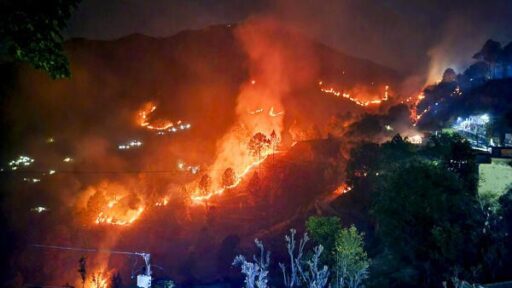
Introduction: A Year of Extreme Wildfires
India witnessed a severe forest fire crisis during the 2023–2024 season. From November 2023 through June 2024, more than 2,03,544 fire incidents were recorded nationwide. States like Madhya Pradesh, Uttarakhand, Chhattisgarh, Odisha, and Telangana reported the highest incidents, with Telangana alone suffering 13,497 fire outbreaks in 2024. With climate volatility rising and detection systems under strain, the season highlighted critical flaws in India’s wildfire management.
How the Fires Started and Spread
Several factors combined to turn ordinary dry seasons into disaster zones:
-
Extended heatwaves across the Himalayas, especially in Himachal Pradesh and Uttarakhand, fueled ignition in pine-dense forests.
- Dry vegetation accumulation—due to lack of ground management and leaf litter—served as tinder for rampant fires.
- Human activities, including crop residue burning, illegal settlements, and unplanned development, significantly increased ignition points.
Human and Environmental Toll
The fires destroyed over 34,562 sq km of forest cover, roughly 1% of India’s total area. The damage impacted biodiversity, reduced air quality, and led to annual economic losses estimated at ₹1,100 crore.
Wildlife loss included deaths of endangered species; agricultural and tribal communities also lost livelihoods. Wildlife experts noted significant decline in bird and butterfly populations in affected areas.
State-wise Breakdown
-
Uttarakhand topped the list with over 1,368 fire events in April alone and more than 1,100 hectares burned.
- Himachal Pradesh suffered 1,343 fires, especially near Shimla, threatening villages and important ecological zones like Tara Devi forests.
- Telangana reported 13,497 incidents—one of the highest counts—with Mulugu and Bhadradri Kothagudem districts emerging as critical hotspots.
Response Efforts and Technology Integration
India deployed a multi-pronged strategy:
-
Satellite monitoring and AI-based alerts through portals like MODIS and SNPP‑VIIRS, plus the Van Agni Portal, allowed early fire detection and real-time communication with district teams.
- Forest departments introduced satellite-based farm fire zoning SOPs, categorizing high-risk villages and enforcing fines between ₹5,000–₹30,000 along with FIRs for repeat offenses.
- Fire patrol teams were positioned in high-risk zones—especially around Gurgaon, Faridabad, Nuh—covering nearly 100 acres daily to ensure faster containment.
Community Engagement & Cultural Interventions
Creative approaches blended cultural outreach and grassroots awareness:
-
In Odisha’s tribal regions, women-led sankirtan mandalis used devotional songs with fire-safety messages, reducing fire incidents from dozens to a fraction.
-
Local school and village groups conducted fire brigades, awareness drives, and tree planting—highlighting collective responsibility to prevent fire risk.
Key Challenges and Systemic Gaps
Despite improved systems, persistent gaps remain:
-
Underfunded fireguard teams in states like Uttarakhand criticized delayed salaries and outdated equipment
-
Enforcement vs innovation disconnect: Satellite alerts often lacked ground follow-up in remote areas.
-
Land-use planning blind spots: Unregulated hill cutting and road expansions near forests heightened risk, especially in Uttarakhand and Karnataka
-
Underfunded fireguard teams in states like Uttarakhand criticized delayed salaries and outdated equipment
-
Enforcement vs innovation disconnect: Satellite alerts often lacked ground follow-up in remote areas.
-
Land-use planning blind spots: Unregulated hill cutting and road expansions near forests heightened risk, especially in Uttarakhand and Karnataka
Long-Term Risks: Climate, Carbon & Policy Implications
Forest fires exacerbate climate feedback loops. India emits 50–80 million tonnes of CO₂ annually from such blazes, undermining reforestation goals under climate pledges.
With annual fire seasons expected to grow in frequency and intensity, policymakers stress the need for:
-
Regular contour lines and fire breaks
-
Climate-adaptive land management
-
Community-led afforestation and patrol groups
What Needs to Change?
To build resilience, India must:
-
Fully integrate AI fire-detection with local response squads
-
Increase budget for modern firefighting infrastructure and trained personnel
-
Enforce land-use laws and avoid construction near ecologically sensitive slopes
-
Empower local volunteers and indigenous networks for fire mitigation
-
Align with climate roadmap to reduce national forest loss and support restoration by 2030
Final Thought
India’s 2024 forest fire season was a climate wake-up call—highlighting the intricate links between environment, livelihood, public health, and policy. While national responses are improving, the real pathway to protecting forests and communities lies in local action, technological integration, and urgent systemic reform.